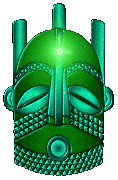http://www.artyfactory.com/africanmasks/index.htm
You should be at a website called Art Factory and you should see pictures of African Masks
Click on the mask that says African Masks Information
 (This mask!)
(This mask!)The artist holds a respected position in African tribal society. It is his job to provide the various masks and sculptures for use in ritual ceremonies. His work is valued for its spiritual, rather than its aesthetic qualities.
(scroll down to the bottom of the page where you will see 16 different mask pictures)
Choose 4 masks that look interesting to you and for EACH mask answer the set of questions below. One of the masks you choose will be the mask you use for the final project.
Mask 1:
What is the name of the mask?
What country is the mask from?
What colors do you see on the mask?
What shapes/designs do you see on the mask?
Tell me one other fact about this mask:
Sketch the mask:
Mask 2:
What is the name of the mask?
What country is the mask from?
What colors do you see on the mask?
What shapes/designs do you see on the mask?
Tell me one other fact about this mask:
Sketch the mask:
Mask 3:
What is the name of the mask?
What country is the mask from?
What colors do you see on the mask?
What shapes/designs do you see on the mask?
Tell me one other fact about this mask:
Sketch the mask:
Mask 4:
What is the name of the mask?
What country is the mask from?
What colors do you see on the mask?
What shapes/designs do you see on the mask?
Tell me one other fact about this mask:
Sketch the mask:
What is your favorite mask you looked at today? ___________________________
If you have extra time look at the other masks on this website and explore the other information, try taking the mask quiz!
You MAY NOT surf the web or play online games.






















































